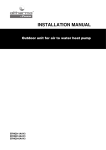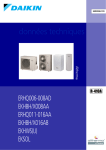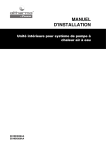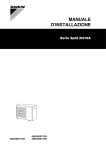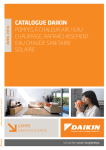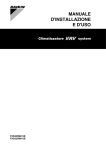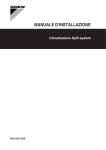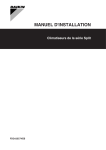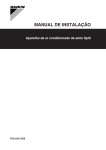Download INSTALLATION MANUAL
Transcript
INSTALLATION MANUAL Outdoor unit for air to water heat pump ERHQ006ADV3 ERHQ007ADV3 ERHQ008ADV3 ERHQ006ADV39 ERHQ007ADV39 ERHQ008ADV39 CE - DECLARACION-DE-CONFORMIDAD CE - DICHIARAZIONE-DI-CONFORMITA CE - ¢H§ø™H ™YMMOPºø™H™ 05 Nota * 04 Bemerk * 03 Remarque * 02 Hinweis * 01 Note * 19 ob upoštevanju določb: 20 vastavalt nõuetele: 21 следвайки клаузите на: 22 laikantis nuostatų, pateikiamų: 23 ievērojot prasības, kas noteiktas: 24 održiavajúc ustanovenia: 25 bunun koşullarına uygun olarak: delineato nel <A> e giudicato positivamente da <B> secondo il Certificato <C>. 07 ™ËÌ›ˆÛË * fiˆ˜ ηıÔÚ›˙ÂÙ·È ÛÙÔ <A> Î·È ÎÚ›ÓÂÙ·È ıÂÙÈο ·fi ÙÔ <B> Û‡Ìʈӷ Ì ÙÔ ¶ÈÛÙÔÔÈËÙÈÎfi <C>. 08 Nota * tal como estabelecido em <A> e com o parecer positivo de <B> de acordo com o Certificado <C>. 09 Примечание * как указано в <A> и в соответствии с положительным решением <B> согласно Свидетельству <C>. 10 Bemærk * som anført i <A> og positivt vurderet af <B> i henhold til Certifikat <C>. 06 Nota * 10 under iagttagelse af bestemmelserne i: 11 enligt villkoren i: 12 gitt i henhold til bestemmelsene i: 13 noudattaen määräyksiä: 14 za dodržení ustanovení předpisu: 15 prema odredbama: 16 követi a(z): 17 zgodnie z postanowieniami Dyrektyw: 18 în urma prevederilor: as set out in <A> and judged positively by <B> according to the Certificate <C>. wie in der <A> aufgeführt und von <B> positiv beurteilt gemäß Zertifikat <C>. tel que défini dans <A> et évalué positivement par <B> conformément au Certificat <C>. zoals vermeld in <A> en positief beoordeeld door <B> overeenkomstig Certificaat <C>. como se establece en <A> y es valorado positivamente por <B> de acuerdo con el Certificado <C>. 01 following the provisions of: 02 gemäß den Vorschriften der: 03 conformément aux stipulations des: 04 overeenkomstig de bepalingen van: 05 siguiendo las disposiciones de: 06 secondo le prescrizioni per: 07 Ì ًÚËÛË Ùˆv ‰È·Ù¿Íˆv Ùˆv: 08 de acordo com o previsto em: 09 в соответствии с положениями: EN60335-2-40, 01 are in conformity with the following standard(s) or other normative document(s), provided that these are used in accordance with our instructions: 02 der/den folgenden Norm(en) oder einem anderen Normdokument oder -dokumenten entspricht/entsprechen, unter der Voraussetzung, daß sie gemäß unseren Anweisungen eingesetzt werden: 03 sont conformes à la/aux norme(s) ou autre(s) document(s) normatif(s), pour autant qu'ils soient utilisés conformément à nos instructions: 04 conform de volgende norm(en) of één of meer andere bindende documenten zijn, op voorwaarde dat ze worden gebruikt overeenkomstig onze instructies: 05 están en conformidad con la(s) siguiente(s) norma(s) u otro(s) documento(s) normativo(s), siempre que sean utilizados de acuerdo con nuestras instrucciones: 06 sono conformi al(i) seguente(i) standard(s) o altro(i) documento(i) a carattere normativo, a patto che vengano usati in conformità alle nostre istruzioni: 07 Â›Ó·È Û‡Ìʈӷ Ì ÙÔ(·) ·ÎfiÏÔ˘ıÔ(·) ÚfiÙ˘Ô(·) ‹ ¿ÏÏÔ ¤ÁÁÚ·ÊÔ(·) ηÓÔÓÈÛÌÒÓ, ˘fi ÙËÓ ÚÔ¸fiıÂÛË fiÙÈ ¯ÚËÛÈÌÔÔÈÔ‡ÓÙ·È Û‡Ìʈӷ Ì ÙȘ Ô‰ËÁ›Â˜ Ì·˜: * = , , -, 1, 2, 3, ..., 9, A, B, C, ..., Z ERHQ006ADV3*, ERHQ007ADV3*, ERHQ008ADV3*, CE - ERKLÆRING OM-SAMSVAR CE - ILMOITUS-YHDENMUKAISUUDESTA CE - PROHLÁŠENÍ-O-SHODĚ Jiro Tomita Director Quality Assurance Ostend, 1st of September 2008 11 Information * enligt <A> och godkänts av <B> enligt Certifikatet <C>. 12 Merk * som det fremkommer i <A> og gjennom positiv bedømmelse av <B> ifølge Sertifikat <C>. 13 Huom * jotka on esitetty asiakirjassa <A> ja jotka <B> on hyväksynyt Sertifikaatin <C> mukaisesti. 14 Poznámka * jak bylo uvedeno v <A> a pozitivně zjištěno <B> v souladu s osvědčením <C>. 15 Napomena * kako je izloženo u <A> i pozitivno ocijenjeno od strane <B> prema Certifikatu <C>. 16 Megjegyzés * a(z) <A> alapján, a(z) <B> igazolta a megfelelést, a(z) <C> tanúsítvány szerint. 17 Uwaga * zgodnie z dokumentacją <A>, pozytywną opinią <B> i Świadectwem <C>. 18 Notă * aşa cum este stabilit în <A> şi apreciat pozitiv de <B> în conformitate cu Certificatul <C>. 19 Opomba * kot je določeno v <A> in odobreno s strani <B> v skladu s certifikatom <C>. 20 Märkus * nagu on näidatud dokumendis <A> ja heaks kiidetud <B> järgi vastavalt sertifikaadile <C>. Low Voltage 2006/95/EC Machinery 98/37/EC Electromagnetic Compatibility 2004/108/EC * CE - ATITIKTIES-DEKLARACIJA CE - ATBILSTĪBAS-DEKLARĀCIJA CE - VYHLÁSENIE-ZHODY CE - UYUMLULUK-BİLDİRİSİ 21 Забележка * както е изложено в <A> и оценено положително от <B> съгласно Cертификата <C>. 22 Pastaba * kaip nustatyta <A> ir kaip teigiamai nuspręsta <B> pagal Sertifikatą <C>. 23 Piezīmes * kā norādīts <A> un atbilstoši <B> pozitīvajam vērtējumam saskaņā ar sertifikātu <C>. 24 Poznámka * ako bolo uvedené v <A> a pozitívne zistené <B> v súlade s osvedčením <C>. 25 Not * <A>‘da belirtildiği gibi ve <C> Sertifikasına göre <B> tarafından olumlu olarak değerlendirildiği gibi. KEMA (NB0344) 74736-KRQ/EMC97-4957 <C> DAIKIN.TCF.015M6/08-2008 19 Direktive z vsemi spremembami. 20 Direktiivid koos muudatustega. 21 Директиви, с техните изменения. 22 Direktyvose su papildymais. 23 Direktīvās un to papildinājumos. 24 Smernice, v platnom znení. 25 Değiştirilmiş halleriyle Yönetmelikler. <B> <A> 10 Direktiver, med senere ændringer. 11 Direktiv, med företagna ändringar. 12 Direktiver, med foretatte endringer. 13 Direktiivejä, sellaisina kuin ne ovat muutettuina. 14 v platném znění. 15 Smjernice, kako je izmijenjeno. 16 irányelv(ek) és módosításaik rendelkezéseit. 17 z późniejszymi poprawkami. 18 Directivelor, cu amendamentele respective. 16 megfelelnek az alábbi szabvány(ok)nak vagy egyéb irányadó dokumentum(ok)nak, ha azokat előírás szerint használják: 17 spełniają wymogi następujących norm i innych dokumentów normalizacyjnych, pod warunkiem że używane są zgodnie z naszymi instrukcjami: 18 sunt în conformitate cu următorul (următoarele) standard(e) sau alt(e) document(e) normativ(e), cu condiţia ca acestea să fie utilizate în conformitate cu instrucţiunile noastre 19 skladni z naslednjimi standardi in drugimi normativi, pod pogojem, da se uporabljajo v skladu z našimi navodili: 20 on vastavuses järgmis(t)e standardi(te)ga või teiste normatiivsete dokumentidega, kui neid kasutatakse vastavalt meie juhenditele: 21 съответстват на следните стандарти или други нормативни документи, при условие, че се използват съгласно нашите инструкции: 22 atitinka žemiau nurodytus standartus ir (arba) kitus norminius dokumentus su sąlyga, kad yra naudojami pagal mūsų nurodymus: 23 tad, ja lietoti atbilstoši ražotāja norādījumiem, atbilst sekojošiem standartiem un citiem normatīviem dokumentiem: 24 sú v zhode s nasledovnou(ými) normou(ami) alebo iným(i) normatívnym(i) dokumentom(ami), za predpokladu, že sa používajú v súlade s našim návodom: 25 ürünün, talimatlarımıza göre kullanılması koşuluyla aşağıdaki standartlar ve norm belirten belgelerle uyumludur: 01 Directives, as amended. 02 Direktiven, gemäß Änderung. 03 Directives, telles que modifiées. 04 Richtlijnen, zoals geamendeerd. 05 Directivas, según lo enmendado. 06 Direttive, come da modifica. 07 √‰ËÁÈÒv, fiˆ˜ ¤¯Ô˘Ó ÙÚÔÔÔÈËı›. 08 Directivas, conforme alteração em. 09 Директив со всеми поправками. 08 estão em conformidade com a(s) seguinte(s) norma(s) ou outro(s) documento(s) normativo(s), desde que estes sejam utilizados de acordo com as nossas instruções: 09 соответствуют следующим стандартам или другим нормативным документам, при условии их использования согласно нашим инструкциям: 10 overholder følgende standard(er) eller andet/andre retningsgivende dokument(er), forudsat at disse anvendes i henhold til vore instrukser: 11 respektive utrustning är utförd i överensstämmelse med och följer följande standard(er) eller andra normgivande dokument, under förutsättning att användning sker i överensstämmelse med våra instruktioner: 12 respektive utstyr er i overensstemmelse med følgende standard(er) eller andre normgivende dokument(er), under forutssetning av at disse brukes i henhold til våre instrukser: 13 vastaavat seuraavien standardien ja muiden ohjeellisten dokumenttien vaatimuksia edellyttäen, että niitä käytetään ohjeidemme mukaisesti: 14 za předpokladu, že jsou využívány v souladu s našimi pokyny, odpovídají následujícím normám nebo normativním dokumentům: 15 u skladu sa slijedećim standardom(ima) ili drugim normativnim dokumentom(ima), uz uvjet da se oni koriste u skladu s našim uputama: CE - IZJAVA O SKLADNOSTI CE - VASTAVUSDEKLARATSIOON CE - ДЕКЛАРАЦИЯ-ЗА-СЪОТВЕТСТВИЕ 17 m deklaruje na własną wyłączną odpowiedzialność, że urządzenia, których ta deklaracja dotyczy: 18 r declară pe proprie răspundere că echipamentele la care se referă această declaraţie: 19 o z vso odgovornostjo izjavlja, da je oprema naprav, na katero se izjava nanaša: 20 x kinnitab oma täielikul vastutusel, et käesoleva deklaratsiooni alla kuuluv varustus: 21 b декларира на своя отговорност, че оборудването, за което се отнася тази декларация: 22 t visiška savo atsakomybe skelbia, kad įranga, kuriai taikoma ši deklaracija: 23 v ar pilnu atbildību apliecina, ka tālāk aprakstītās iekārtas, uz kurām attiecas šī deklarācija: 24 k vyhlasuje na vlastnú zodpovednosť, že zariadenie, na ktoré sa vzťahuje toto vyhlásenie: 25 w tamamen kendi sorumluluğunda olmak üzere bu bildirinin ilgili olduğu donanımının aşağıdaki gibi olduğunu beyan eder: CE - IZJAVA-O-USKLAĐENOSTI CE - MEGFELELŐSÉGI-NYILATKOZAT CE - DEKLARACJA-ZGODNOŚCI CE - DECLARAŢIE-DE-CONFORMITATE 09 u заявляет, исключительно под свою ответственность, что оборудование, к которому относится настоящее заявление: 10 q erklærer som eneansvarlig, at udstyret, som er omfattet af denne erklæring: 11 s deklarerar i egenskap av huvudansvarig, att utrustningen som berörs av denna deklaration innebär att: 12 n erklærer et fullstendig ansvar for at det utstyr som berøres av denne deklarasjon, innebærer at: 13 j ilmoittaa yksinomaan omalla vastuullaan, että tämän ilmoituksen tarkoittamat laitteet: 14 c prohlašuje ve své plné odpovědnosti, že zařízení, k němuž se toto prohlášení vztahuje: 15 y izjavljuje pod isključivo vlastitom odgovornošću da oprema na koju se ova izjava odnosi: 16 h teljes felelőssége tudatában kijelenti, hogy a berendezések, melyekre e nyilatkozat vonatkozik: CE - DECLARAÇÃO-DE-CONFORMIDADE СЕ - ЗАЯВЛЕНИЕ-О-СООТВЕТСТВИИ CE - OPFYLDELSESERKLÆRING CE - FÖRSÄKRAN-OM-ÖVERENSTÄMMELSE 01 a declares under its sole responsibility that the equipment to which this declaration relates: 02 d erklärt auf seine alleinige Verantwortung, dass die Ausrüstung für die diese Erklärung bestimmt ist: 03 f déclare sous sa seule responsabilité que l’équipement visé par la présente déclaration: 04 l verklaart hierbij op eigen exclusieve verantwoordelijkheid dat de apparatuur waarop deze verklaring betrekking heeft: 05 e declara bajo su única responsabilidad que el equipo al que hace referencia la declaración: 06 i dichiara sotto la propria responsabilità che gli apparecchi a cui è riferita questa dichiarazione: 07 g ‰ËÏÒÓÂÈ Ì ·ÔÎÏÂÈÛÙÈ΋ Ù˘ ¢ı‡ÓË fiÙÈ Ô ÂÍÔÏÈÛÌfi˜ ÛÙÔÓ ÔÔ›Ô ·Ó·Ê¤ÚÂÙ·È Ë ·ÚÔ‡Û· ‰‹ÏˆÛË: 08 p declara sob sua exclusiva responsabilidade que os equipamentos a que esta declaração se refere: Daikin Europe N.V. CE - DECLARATION-OF-CONFORMITY CE - KONFORMITÄTSERKLÄRUNG CE - DECLARATION-DE-CONFORMITE CE - CONFORMITEITSVERKLARING 3PW33141-5F ERHQ006ADV3 ERHQ007ADV3 ERHQ008ADV3 ERHQ006ADV39 ERHQ007ADV39 ERHQ008ADV39 Outdoor unit for air to water heat pump CONTENTS Page ■ Safety precautions ............................................................................. 1 Model................................................................................................. 2 Installation manual After completing installation, test the unit to check for installation errors. Give the user adequate instructions concerning the use and cleaning of the unit as included in the operation manual of the indoor unit. Accessories ....................................................................................... 2 Installation guidelines ........................................................................ 2 Precautions for selecting the location ........................................................ 2 Selecting a location in cold climates .......................................................... 2 Refrigerant piping specifications ................................................................ 3 Installing near a wall or obstacle................................................................ 3 Outdoor unit installation drawing................................................................ 3 Installation procedure ........................................................................ 4 Mounting the outdoor unit .......................................................................... 4 Drain work.................................................................................................. 4 Flaring the pipe end ................................................................................... 4 Connecting the refrigerant piping to the outdoor unit................................. 4 Refrigerant piping work .............................................................................. 5 Purging air and checking gas leakage ....................................................... 5 Charging refrigerant ................................................................................... 6 Wiring......................................................................................................... 6 Warnings ■ Installation should be left to the dealer or another professional. Improper installation may cause water leakage, electrical shock, or fire. ■ Install the outdoor unit according to the instructions given in this manual. Incomplete installation may cause water leakage, electrical shock, or fire. ■ Be sure to use the supplied or specified installation parts. Use of other parts may cause the unit to vibrate loose, and may cause water leakage, electrical shock, or fire. ■ Install the outdoor unit on a solid base that can support the weight of the unit. An inadequate base or incomplete installation may cause injury in the event the unit falls off the base. ■ Electrical work must be carried out in accordance with the installation manual and the national electrical wiring rules or code of practice. Insufficient capacity or incomplete electrical work may cause electrical shock or fire. ■ Be sure to use a dedicated power circuit. Never use a power circuit shared by another appliance. ■ For wiring, use a cable long enough to cover the entire distance with no connection. Do not use an extension cord. Do not put other loads on the power supply, use a dedicated power circuit. Failure to do so may cause abnormal heat, electric shock, or fire. ■ Use the specified types of wires for electrical connections between the indoor and outdoor unit. Firmly clamp the interconnecting wires so that their terminals receive no external stress. Incomplete connections or clamping may cause terminal overheating or fire. ■ After connecting the interconnecting and supply wiring, be sure to shape the cables so that they do not put undue force on the electrical covers or panels. Install covers over the wires. Incomplete cover installation may cause terminal overheating, electrical shock, or fire. ■ If any refrigerant has leaked out during the installation work, ventilate the room. The refrigerant produces a toxic gas if exposed to flames. ■ After all installation is complete, check to make sure that no refrigerant is leaking. The refrigerant produces a toxic gas if exposed to flames. ■ When installing or relocating the system, be sure to keep the refrigerant circuit free from substances other than the specified refrigerant (R410A), such as air. Any presence of air or other foreign substance in the refrigerant circuit causes an abnormal pressure rise or rupture, resulting in injury. ■ During pump down operation, stop the compressor before removing the refrigerant piping. If the compressor is still running and the stop valve is open during pump-down, air will be sucked in when the refrigerant piping is removed, causing abnormal pressure in the freezer cycle which will lead to breakage and even to injury. Test run and final check..................................................................... 8 Trial operation and testing.......................................................................... 8 Items to check............................................................................................ 8 Pump down operation........................................................................ 8 Pump down procedure............................................................................... 8 Forced cooling operation............................................................................ 8 Disposal requirements....................................................................... 8 READ THESE INSTRUCTIONS CAREFULLY BEFORE INSTALLATION. KEEP THIS MANUAL IN A HANDY PLACE FOR FUTURE REFERENCE. IMPROPER INSTALLATION OR ATTACHMENT OF EQUIPMENT OR ACCESSORIES COULD RESULT IN ELECTRIC SHOCK, SHORT-CIRCUIT, LEAKS, FIRE OR OTHER DAMAGE TO THE EQUIPMENT. BE SURE ONLY TO USE ACCESSORIES MADE BY DAIKIN WHICH ARE SPECIFICALLY DESIGNED FOR USE WITH THE EQUIPMENT AND HAVE THEM INSTALLED BY A PROFESSIONAL. IF UNSURE OF INSTALLATION PROCEDURES OR USE, ALWAYS CONTACT YOUR DAIKIN DEALER FOR ADVICE AND INFORMATION. SAFETY ■ PRECAUTIONS This manual classifies the precautions into WARNING and CAUTION. Be sure to follow all the precautions below: they are all important for ensuring safety. Failure to follow any of WARNING is likely to result in such grave consequences as death or serious injury. Failure to follow any of CAUTION may in some cases result in grave consequences. ■ The following safety symbols are used throughout this manual. Be sure to observe this instruction. Be sure to establish an earth connection. Never attempt. ERHQ006~008ADV3(9) Outdoor unit for air to water heat pump 4PW52841-1 Installation manual 1 ■ ■ ■ During installation, attach the refrigerant piping securely before running the compressor. If the compressor is not attached and the stop valve is open during pump-down, air will be sucked in when the compressor is running, causing abnormal pressure in the freezer cycle which will lead to breakage and even to injury. INSTALLATION Precautions for selecting the location Be sure to establish an earth. Do not earth the unit to a utility pipe, surge absorber, or telephone earth. Incomplete earth may cause electrical shock. A high surge current from lightning or other sources may cause damage to the outdoor unit. WARNING Be sure to install an earth leakage circuit breaker. Failure to do so may cause electrical shock. ■ Do not install the outdoor unit in a place where there is danger of exposure to inflammable gas leakage. If the gas leaks and builds up around the unit, it may catch fire. Tighten the flare nut according to the specified method such as with a torque wrench. If the flare nut is tightened too hard, the flare nut may crack after a long time and cause refrigerant leakage. MODEL ERHQ_V39 units include special equipment to ensure good operation in areas where low ambient temperature can occur together with high humidity conditions. In such conditions the ERHQ_V3 models may experience problems with severe ice build up on the aircooled coil. In case such conditions are expected, the ERHQ_V39 must be installed instead. These models contain countermeasures to prevent freeze up (insulation, a bottom plate heater, ...). ACCESSORIES ■ ■ Make sure to provide for adequate measures in order to prevent that the outdoor unit be used as a shelter by small animals. ■ Small animals making contact with electrical parts can cause malfunctions, smoke or fire. Please instruct the customer to keep the area around the unit clean. ■ The equipment is not intended for use in a potentially explosive atmosphere. ■ Choose a place solid enough to bear the weight and vibration of the unit, where the operation noise will not be amplified. ■ Choose a location where the hot air discharged from the unit or the operation noise will not cause a nuisance to the neighbours of the user. ■ Avoid places near a bedroom and the like, so that the operation noise will cause no trouble. ■ There must be sufficient space for carrying the unit into and out of the site. ■ There must be sufficient space for air passage and no obstructions around the air inlet and the air outlet. ■ The site must be free from the possibility of flammable gas leakage in a nearby place. ■ Locate the unit so that the noise and the discharged hot air will not annoy the neighbours. ■ Install units, power cords and inter-unit cables at least 3 m away from television and radio sets. This is to prevent interference to images and sounds. ■ Depending on radio wave conditions, electromagnetic interference may still occur even if installed more than 3 m away. ■ In coastal areas or other places with salty atmosphere of sulfate gas, corrosion may shorten the life of the outdoor unit. ■ Since drain flows out of the outdoor unit, do not place anything under the unit which must be kept away from moisture. Cautions ■ GUIDELINES Accessories supplied with the outdoor unit: NOTE Installation manual 1x Fluorinated greenhouse gases label 1x Units cannot be installed hanging from ceiling or stacked. Selecting a location in cold climates CAUTION Multilingual fluorinated greenhouse gases label ■ Possible options Bottom plate heater Drain socket ERHQ_V3 Optional kit(1) Optional kit(1) ERHQ_V39 Standard Use prohibited (1) Combination of both options is prohibited. Installation manual 2 When operating the outdoor unit in a low outdoor ambient temperature, be sure to follow the instructions described below. 1x ■ To prevent exposure to wind, install the outdoor unit with its suction side facing the wall. ■ Never install the outdoor unit at a site where the suction side may be exposed directly to wind. ■ To prevent exposure to wind, install a baffle plate on the air discharge side of the outdoor unit. ERHQ006~008ADV3(9) Outdoor unit for air to water heat pump 4PW52841-1 ■ In heavy snowfall areas it is very important to select an installation site where the snow will not affect the unit. If lateral snowfall is possible, make sure that the heat exchanger coil is not affected by the snow (if necessary construct a lateral canopy). Outdoor unit installation drawing 1 Construct a large canopy. Construct a pedestal. Install the unit high enough off the ground to prevent burying in snow. 2 Refrigerant piping specifications 3 Refrigerant piping specifications Maximum allowable piping length between outdoor unit and indoor unit 30 m Minimum required piping length between outdoor unit and indoor unit 3m Maximum allowable height difference between outdoor unit and indoor unit 20 m Additional refrigerant required for refrigerant pipe exceeding 10 m in length 20 g/m Gas pipe - outer diameter 15.9 mm (5/8") Liquid pipe - outer diameter 6.4 mm (1/4") 7 0 33 m m 580 m m 120 m m 6 5 4 Installing near a wall or obstacle ■ ■ Where a wall or other obstacle is in the path of the outdoor unit air intake or exhaust airflow, follow the installation guidelines below. For any of the installation patterns below, the wall height on the exhaust side should be 1200 mm or less. Wall facing one side (unit: mm) >350 Wrap the insulation pipe with finishing tape from bottom to top. 2 Service cover 3 Stop valve cover 4 250 mm from wall. Allow space for piping and electrical servicing. 5 If there is danger of the unit falling or overturning, fix the unit with foundation bolts, or with wire or other means. 6 Distance from the outer side of the stop valve cover 7 If the location does not have good drainage, place the unit on block bases. Adjust foot height until the unit is levelled. Failure to do so may result in water leakage or accumulation. ≤1200 >100 1 Walls facing two sides (unit: mm) >100 >350 >50 >50 Walls facing three sides (unit: mm) >100 >50 >350 ERHQ006~008ADV3(9) Outdoor unit for air to water heat pump 4PW52841-1 Installation manual 3 INSTALLATION PROCEDURE 4 Flare the pipe. Set exactly at the position shown below. A Mounting the outdoor unit Conventional flare tool When installing the outdoor unit, please refer to "Installation guidelines" on page 2 to select an appropriate location. 1 2 3 Check the strength and level of the installation ground so that the unit will not cause any operating vibration or noise after installation. Flare tool for R410A (clutch type) Clutch type (Ridgid-type) Wing nut type (Imperial-type) 0~0.5 mm 1.0~1.5 mm 1.5~2.0 mm A 5 Prepare 4 sets of M8 or M10 foundation bolts, nuts and washers each (field supply). Check that the flaring is properly made. 1 2 Fix the unit securely by means of the foundation bolts in accordance with the foundation drawing. It is best to screw in the foundation bolts until their length remains 20 mm above the foundation surface. 1 Flare's inner surface must be flaw-free. 2 The pipe end must be evenly flared in a perfect circle. 3 Make sure that the flare nut is fitted. 3 20 Connecting the refrigerant piping to the outdoor unit All field piping must be installed by a licensed refrigeration technician and must comply with relevant local and national regulations. Drain work CAUTION Check in the combination table under "Possible options" on page 2 whether drain work is allowed. In case drain work on your unit is allowed and the installation site requires drain work, then follow the guidelines below. ■ Do not use mineral oil on flared part. Mineral oil getting into the system would reduce the lifetime of the units. ■ Drain kits for drainage are available as option. ■ ■ If the drain ports are covered by a mounting base or floor surface, place additional bases of at least 30 mm high under the outdoor unit's feet. Never use piping which has been used for previous installations. Only use parts which are delivered with the unit. ■ Do never install a drier to this R410A unit in order to guarantee its lifetime. The drying material may dissolve and damage the system. ■ Incomplete flaring may cause refrigerant gas leakage. ■ In cold areas, do not use a drain hose with the outdoor unit. Drain water may freeze, impairing the heating performance. In case use of a drain hose is unavoidable for one reason or another, it is recommended to install the optional bottom plate heater tape (EKBPHT). Make sure the drain works properly. 1 When connecting the flare nut, coat the flare inner surface with ether oil or with ester oil and initially tighten 3 or 4 turns by hand before tightening firmly. 2 When loosening a flare nut, always use two wrenches together. 1 1 2 3 4 1 Drain water holes 2 Bottom frame 3 Drain socket (optional) 4 Hose (field supply, inner diameter 16 mm) When connecting the piping, always use a spanner and torque wrench together to tighten the flare nut to prevent nut cracking and leaks. 1 2 Flaring the pipe end 3 To flare each pipe end, follow the procedure below: 1 Cut the pipe end with a pipe cutter. 2 Remove burrs with the cut surface facing downward so that the chips do not enter the pipe. 1 Torque wrench 2 Spanner 3 Piping union 4 Flare nut 4 Flare nut Flare nut tightening torque Ø6.4 mm (1/4") 15~17 N•m Ø15.9 mm (5/8") 63~75 N•m Valve cap tightening torque 1 3 2 Gas pipe 1 Cut exactly at right angles. Ø6.4 mm (1/4") 21.6~27.4 N•m 2 Remove burrs Ø15.9 mm (5/8") 44.1~53.9 N•m Remove the flare nut from the stop valve and put the flare nut on the pipe. Installation manual 4 Valve cap Service port cap tightening torque 10.8~14.7 N•m ERHQ006~008ADV3(9) Outdoor unit for air to water heat pump 4PW52841-1 ■ Refrigerant piping work All refrigerant pipe joints should be tightened with a torque wrench at the specified tightening torque. See "Connecting the refrigerant piping to the outdoor unit" on page 4 for details. Pipe handling guidelines ■ Protect the open end of the pipe against dust and moisture. ■ All pipe bends should be as gentle as possible. Use a pipe bender for bending. Bending radius should be 30 to 40 mm or larger. 1 4 8 2 3 1 Pressure meter 2 Gauge manifold 3 Low-pressure valve (Lo) 4 High-pressure valve (Hi) 5 Charging hoses 6 Vacuum pump 7 Service port 8 Valve lids 9 Gas stop valve 10 Liquid stop valve 10 5 6 7 8 9 Selection of copper and heat insulation materials When using commercial copper pipes and fittings, observe the following: ■ ■ Insulation material: polyethylene foam Heat transfer rate: 0.041 to 0.052 W/mK (0.035 to 0.045 kcal/ mh°C) Refrigerant gas pipe's surface temperature reaches 110°C max. Choose heat insulation materials that will withstand this temperature. 1 Connect the projection side (on which the worm pin is pressed) of the charging hose coming from the gauge manifold to the gas stop valve's service port. 2 Fully open the gauge manifold's low-pressure valve (Lo) and completely close its high-pressure valve (Hi). The high-pressure valve subsequently requires no operation. 3 Apply vacuum pumping. Check that the compound pressure gauge reads –0.1 MPa (–760 mm Hg). Be sure to insulate both the gas and liquid piping and to provide insulation dimensions as below. Pipe length Pipe size Pipe insulation Outer diameter Thickness Inner diameter Thickness 6.4 mm (1/4") 0.8 mm 8-10 mm ≥10 mm 15.9 mm (5/8") 1.0 mm 16-20 mm ≥13 mm 2 1 6 5 ■ 3 4 1 Gas pipe 2 Inter-unit wiring 3 Liquid pipe 4 Liquid pipe insulation 5 Finishing tape 6 Gas pipe insulation Use separate thermal insulation pipes for gas and liquid refrigerant pipes. Run time 4 Do not mix any substance other than the specified refrigerant (R410A) into the refrigeration cycle. ■ When refrigerant gas leaks occur, ventilate the room as soon and as much as possible. ■ R410A, as well as other refrigerants, should always be recovered and never be released directly into the environment. ≥10 minutes ≥15 minutes Close the gauge manifold's low-pressure valve (Lo) and stop the vacuum pump. NOTE If the meter needle does go back, this may indicate presence of moisture or leaking from connecting parts. Repeat steps 2 through 4 after checking all connecting parts and slightly loosening and retightening the nuts. 5 Remove the covers from the liquid stop valve and gas stop valve. 6 Turn the liquid stop valve's rod 90 degrees counterclockwise with a hexagonal wrench to open the valve. Close it after 5 seconds, and check for gas leakage. Using soapy water, check for gas leakage from the indoor unit's flare and the outdoor unit's flare and the valve rods. After the check is complete, wipe all soapy water off. When all piping work is completed and the outdoor unit is connected to the indoor unit, it is necessary to purge the air and check for gas leakage. ■ >15 m Leave as is for 4-5 minutes and make sure that the coupling meter needle does not go back. Purging air and checking gas leakage WARNING ≤15 m 7 Disconnect the charging hose from the gas stop valve's service port, then fully open the liquid and gas stop valves. Do not attempt to turn the valve rod beyond its stop. 8 Tighten the valve lids and service port caps for the liquid and gas stop valves with a torque wrench at the specified torques. See "Connecting the refrigerant piping to the outdoor unit" on page 4 for details. CAUTION Use a vacuum pump for R410A exclusively. Using the same vacuum pump for different refrigerants may damage the vacuum pump or the unit. ■ If using additional refrigerant, perform air purging from the refrigerant pipes and indoor unit using a vacuum pump, then charge additional refrigerant. ■ Use a hexagonal wrench (4 mm) to operate the stop valve rod. ERHQ006~008ADV3(9) Outdoor unit for air to water heat pump 4PW52841-1 Installation manual 5 Charging additional refrigerant Charging refrigerant If the total length of refrigerant piping exceeds 10 m in length, additionally charge with 20 g of refrigerant (R410A) for each additional meter of piping. This outdoor unit is factory charged. Important information regarding the refrigerant used This product contains fluorinated greenhouse gases covered by the Kyoto Protocol. Do not vent gases into the atmosphere. Refrigerant type: R410A GWP(1) value: 1975 (1) Determine the weight of refrigerant to be charged additionally and fill in the amount in the service sticker on the rear side of the stop valve cover. Precautions when adding R410A ■ Be sure to charge the specified amount of refrigerant in liquid state to the liquid pipe. Since this refrigerant is a mixed refrigerant, adding it in gas form may cause the refrigerant composition to change, preventing normal operation. ■ Before charging, check whether the refrigerant cylinder is equipped with a siphon tube or not (the cylinder should be marked with "liquid filling siphon attached" or something similar). GWP = global warming potential Please fill in with indelible ink, ■ ➀ the factory refrigerant charge of the product, ■ ➁ the additional refrigerant amount charged in the field and ■ ➀+➁ the total refrigerant charge on the fluorinated greenhouse gases label supplied with the product. Charge the liquid refrigerant with the cylinder in upright position. The filled out label must be adhered on the inside of the product and in the proximity of the product charging port (e.g. on the inside of the service cover). 4 1 Factory refrigerant charge of the product: see unit name plate 1 2 Additional refrigerant amount charged in the field 3 Total refrigerant charge 4 Contains fluorinated greenhouse gases covered by the Kyoto Protocol 5 Outdoor unit 6 Refrigerant cylinder and manifold for charging 2 3 6 NOTE 5 National implementation of EU regulation on certain fluorinated greenhouse gases may require to provide the appropriate official national language on the unit. Therefore, an additional multilingual fluorinated greenhouse gases label is supplied with the unit. Sticking instructions are illustrated on the backside of that label. ■ Be sure to use tools exclusively for R410A to ensure required pressure resistance and to prevent foreign materials from mixing into the system. Wiring WARNING ■ All wiring must be performed by an authorized electrician. ■ The power supply cable and circuit breaker must be selected in accordance with local and national regulations. ■ Do not use tapped wires, stranded conductor wires (see caution 1 under "Notes to observe" on page 7), extension cords, or connections from a star system, as they may cause overheating, electrical shock or fire. ■ Do not use locally purchased electrical parts inside the product and do not branch the power for the heater tape, etc., from the terminal block. Doing this may cause electrical shock or fire. ■ Be sure to install an earth leakage circuit breaker. This unit uses an inverter, which means that an earth leakage circuit breaker capable of handling high harmonics needs to be used in order to prevent malfunctioning of the earth leakage circuit breaker itself. ■ A main switch or other means for disconnection, having a contact separation in all poles, must be incorporated in the fixed wiring in accordance with relevant local and national legislation. Re-charging In case re-charging is required, refer to the nameplate of the unit. The nameplate states the type of refrigerant and necessary amount. Charge the liquid refrigerant with the cylinder in up-side-down position. WARNING Do not turn ON the safety breaker until all work is completed. Equipment complying with EN/IEC 61000-3-12 (1) (1) European/International Technical Standard setting the limits for harmonic currents produced by equipment connected to public low-voltage systems with input current >16 A and ≤75 A per phase. Installation manual 6 ERHQ006~008ADV3(9) Outdoor unit for air to water heat pump 4PW52841-1 Procedure Notes to observe 1 Strip the insulation from the wire (20 mm). Observe the notes mentioned below when wiring to the power supply terminal board. 2 Connect the connection wires between the indoor and outdoor units so that the terminal numbers match (see wiring diagram below). Tighten the terminal screws securely. We recommend a flathead screwdriver to tighten the screws. See also caution 2 under "Notes to observe" on page 7 for wiring guidelines. 1 2 L 3 N 1 2 3 123 2 LN 1 2 3 1 1 2 3 50 Hz 230 V 3 3 4 5 1 Interconnection between indoor unit and outdoor unit : when wire length exceeds 10 m, use Ø2.5 mm wires instead of Ø1.5 mm wires. 2 Power supply cable (refer to the unit nameplate for maximum running current) 3 Earth 4 Safety breaker 5 Earth leakage circuit breaker 3 ■ Use the specified wire type and connect it securely (1). ■ Firmly secure the wire clamp so that wire terminations do not receive external stress (2). ■ Shape wires so that the service cover and stop valve cover fit securely (3). H05VV 1 2 CAUTION 1. In case the use of stranded conductor wires is unavoidable for one reason or another, make sure to install round crimp-style terminals on the tip. Place the round crimp-style terminal on the wire up to the covered part and fasten the terminal with the appropriate tool. Earth terminal installation This unit must be earthed. NOTE For earthing, follow the applicable local standard for electrical installations. 2 ■ Use the following method when installing single core wires. 32 2. AA' A A' 1 1 Stranded conductor wire 2 Round crimp-style terminal When connecting the connection wires to the terminal board using a single core wire, be sure to perform curling. 3 1 1 1 Single core wire 2 Screw 3 Flat washer Not executing the connections properly may cause heat and fire. Strip the wire at terminal block: ■ Use the following method when using round crimp-style terminals. 1 32 23 B B 1 4 1 Round crimp-style terminal 2 Screw 3 Flat washer 1 Strip wire end to this point 2 Excessive strip length may cause electrical shock or leakage. Pull the connected wire and make sure that it does not disconnect. Then fix the wires in place in the wire clamp. See also "Notes to observe" on page 7. ERHQ006~008ADV3(9) Outdoor unit for air to water heat pump 4PW52841-1 Installation manual 7 TEST PUMP RUN AND FINAL CHECK Remark that during the first running period of the unit, required power input may be higher than stated on the nameplate of the unit. This phenomenon originates from the compressor that needs elapse of a 50 hours run in period before reaching smooth operation and stable power consumption. NOTE Trial operation and testing DOWN OPERATION In order to protect the environment, be sure to pump down when relocating or disposing of the unit. The pump down operation will extract all refrigerant from the piping into the outdoor unit. Pump down procedure 1 Remove the valve lid from liquid stop valve and gas stop valve. 2 Carry out the forced cooling operation. 1 Measure the voltage at the primary side of the safety breaker. Check that it is 230 V. 3 2 Carry out the test operation in accordance with the indoor installation manual and operation manual to ensure that all functions and parts are working properly. After 5 to 10 minutes (after only 1 or 2 minutes in case of very low ambient temperatures (<–10°C)), close the liquid stop valve with a hexagonal wrench. 4 After 2-3 minutes, close the gas stop valve and stop forced cooling operation. 3 1 If the circuit breaker trips to shut off the power to the outdoor unit, the system will restore the original operation mode when the power supply is restored. Check 4 1 Gas stop valve 2 Close 3 Hexagonal wrench 4 Valve lid 5 Liquid stop valve 5 4 Forced cooling operation Items to check 1 Press the forced operation switch SW1 to begin forced cooling. 2 Press the forced operation switch SW1 again to stop forced cooling. Symptom ■ Outdoor unit is installed properly on solid base. Fall, vibration, noise ■ No refrigerant gas leaks. Incomplete cooling/heating function ■ Refrigerant gas and liquid pipes are thermally insulated. Water leakage ■ System is properly earthed. Electrical leakage ■ The specified wires are used for interconnecting wire connections. Inoperative or burn damage ■ Outdoor unit air intake and exhaust is free of obstructions. Stop valves are opened. Incomplete cooling/heating function NOTE 2 S102 S2 LED-A A B CD ■ The unit requires a small amount of power in its standby mode. If the system is not to be used for some time after installation, shut off the circuit breaker to eliminate unnecessary power consumption. ON ■ NOTE SW4 SW1 Have the customer actually operate the unit while looking at the manual included with the indoor unit. Instruct the customer how to operate the unit correctly. 1 1 NOTE Forced operation switch SW1 Take care that while running forced cooling operation the water temperature remains higher than 5°C (see temperature read out of the indoor unit). You can achieve this, for example, by activating all fans of the fan coil units. DISPOSAL REQUIREMENTS Dismantling of the unit, treatment of the refrigerant, of oil and of other parts must be done in accordance with relevant local and national legislation. Installation manual 8 ERHQ006~008ADV3(9) Outdoor unit for air to water heat pump 4PW52841-1 NOTES 4PW52841-1 Copyright © Daikin












